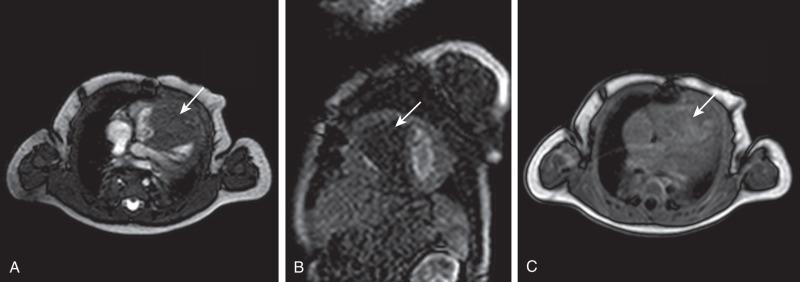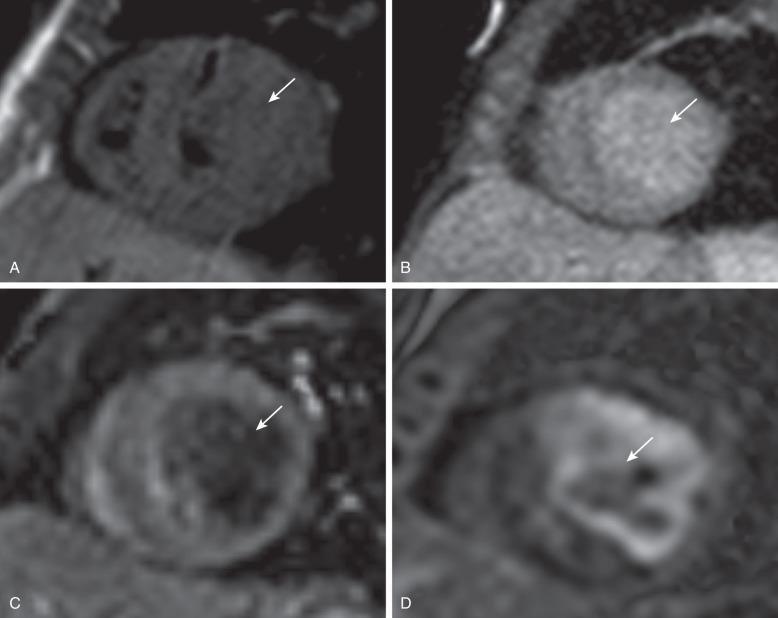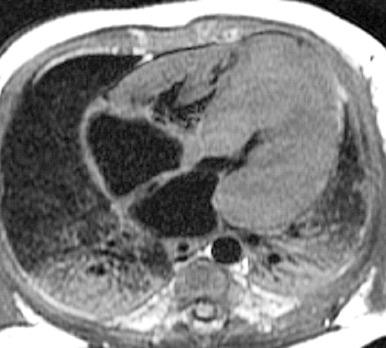Physical Address
304 North Cardinal St.
Dorchester Center, MA 02124
Primary cardiac tumors are rare in children, with a reported prevalence of up to 0.32%. Use of echocardiography has resulted in more frequent detection of cardiac tumors in the fetus and neonate. More than 90% of pediatric cardiac tumors are benign. Symptoms are variable and usually depend on tumor location and size. Intracavitary cardiac tumors can cause cardiac valve obstruction or spread of tumor emboli, and present with heart failure, dyspnea, or neurologic symptoms. Myocardial tumors compress the cardiac lumen, leading to obstruction or heart failure, and can be associated with arrhythmias. Pericardial tumors are associated with pericardial effusions. Conventional radiographs may show cardiomegaly, an abnormal cardiac silhouette, or pulmonary edema ( e-Fig. 80.1 ). Cardiac tumors in children can be associated with several syndromes ( e-Table 80.1 ). Computed tomography (CT) and magnetic resonance imaging (MRI) findings help differentiate tumor types ( Table 80.2 ).
| Tumor | Location | Number | CT | MRI Signal Intensity |
|---|---|---|---|---|
| Rhabdomyoma | Myocardium | Multiple | − Calcification ↑ Attenuation * Mild contrast enhancement |
Isointense T1- and T2-weighted images Decreased signal on FPP Variable contrast enhancement |
| Fibroma | Myocardium | Solitary | + Calcification Heterogeneous enhancement |
Variable T2-weighted signal Decreased signal on FPP Early rim enhancement ↑ Delayed enhancement |
| Myxoma | Intracavitary | Solitary † | + Calcification ↓ Attenuation, outlined by intracavitary contrast |
↑ T2-weighted images Heterogeneous contrast enhancement |
| Teratoma | Pericardium | Solitary | + Calcification + Fat Heterogeneous attenuation |
↑ T2-weighted images ↑ T1-weighted images |
† Multiple and recurrent tumors associated with familial forms.
| Tumor | Association |
|---|---|
| Rhabdomyoma | Tuberous sclerosis |
| Fibroma | Gorlin (basal cell nevus) syndrome |
| Myxoma | Carney syndrome |
Rhabdomyoma, the most common primary cardiac tumor of childhood, accounts for 60% to 79% of all cardiac tumors in infancy. Rhabdomyomas are hamartomas that regress and have no potential for malignancy. Although greater than half of patients with rhabdomyoma are asymptomatic, presentations include nonimmune fetal hydrops, outflow tract obstruction, or arrhythmia. At least 50% of patients with rhabdomyoma have tuberous sclerosis, and rhabdomyomas can be the first manifestation.
Rhabdomyomas are round, hyperechoic, solid masses on echocardiography ( e-Fig. 80.2 ). They usually are multiple and occur most commonly in the ventricular tissue but also can arise from atrial walls. Signal characteristics on T1- and T2-weighted MRI are similar to those of myocardium, making noncontrast MRI less sensitive than echocardiography. They have increased attenuation compared with myocardium on noncontrast-enhanced CT scans, and decreased perfusion and variable postcontrast enhancement on MRI ( Figs. 80.3 and 80.4 ). Small fat globules may be detected.



Cardiac fibroma is the second most common and the most commonly resected primary cardiac tumor of childhood. The tumors are frequently detected in infancy but can present throughout childhood. Fibromas are solitary tumors arising from myocardium composed of fibroblasts and collagen, and can be associated with Gorlin (basal cell nevus) syndrome. Children can present with heart failure and arrhythmia.
Become a Clinical Tree membership for Full access and enjoy Unlimited articles
If you are a member. Log in here